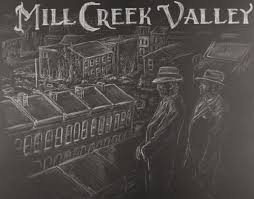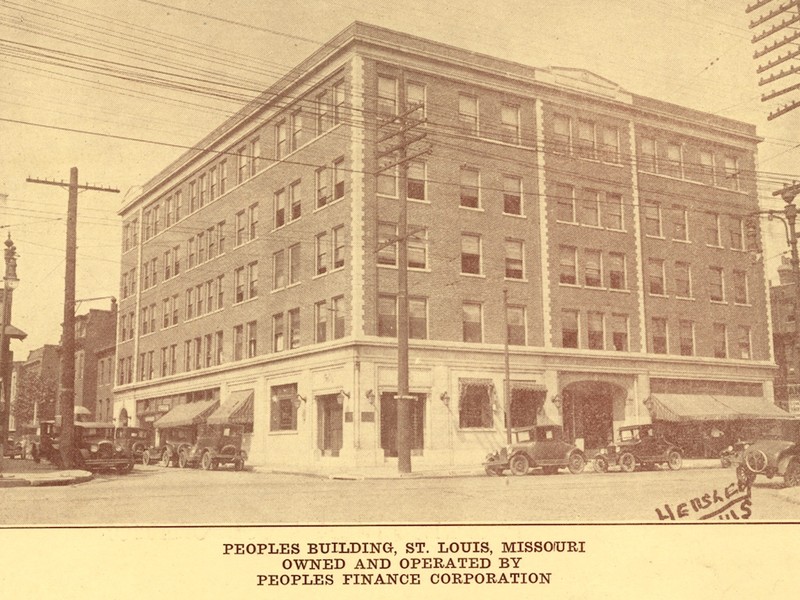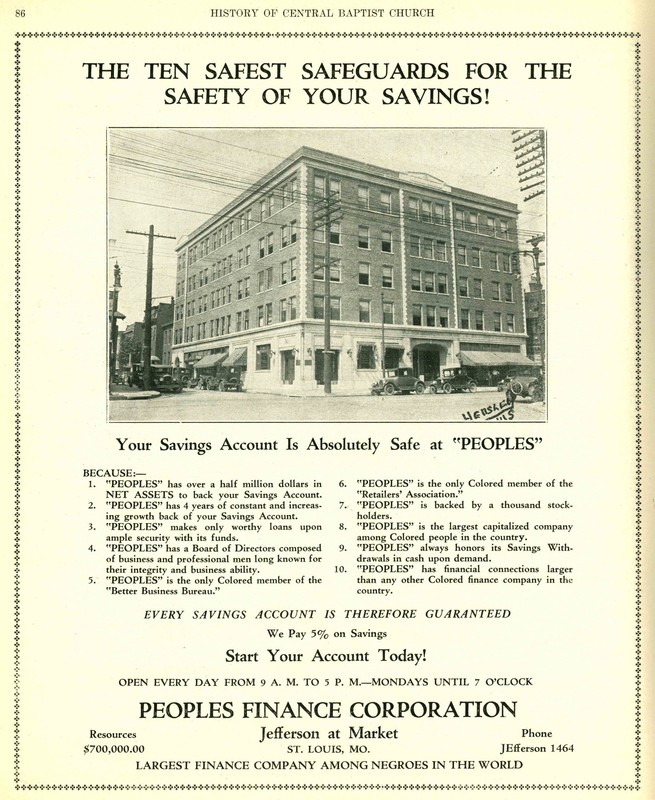People's Finance Corporation/People's Finance Building
Introduction
Text-to-speech Audio
Images
Chalk Drawing by Andy Cross, for Missouri Historical Society's 250 in 250 exhibit

image of People's Finance Building

"Ten Safest Safeguards for the Safety of your Savings" advertisement

Backstory and Context
Text-to-speech Audio
In the early 20th century, amid the shift of America’s Black population northward, African Americans in St. Louis resisted segregation practices and widespread racial hostility as they built a vibrant professional and residential community in the Mill Creek Valley neighborhood, just east of downtown St. Louis. During the mid- and late- 19th century, German immigrants populated the neighborhood, but by early 20th century, African Americans began moving in and the neighborhood became a major locus of Black excellence, racial uplift, and community building.
Central the vision of Mill Creek Valley as a residential, economic, and cultural center for Black St. Louisans, the People’s Finance Corporation (PFC) was founded in 1923 by seven local Black men. The organizers created PFC to provide financing for Black homeowners who were usually shut out of traditional mortgages by the racist practices of White bankers. During the early 20th century, local and national Black leaders envisioned entrepreneurialism as a central strategy towards the larger project of racial uplift, and the People’s Finance Corporation was just such a shining example of Black excellence and community development. According to the National Urban League journal, by 1925 the company was the largest finance entity held entirely by Black people in the entire country.
Shortly after founding PFC, leadership shifted their focus towards building a space to house their offices. But they also envisioned a building that would be a centerpiece of the neighborhood and a community hub. In 1926, built entirely by Black tradesmen, the People’s Finance Building opened at the corner of Jefferson Avenue and Market Street to a large celebration. In total, the five story building featured eighty-one offices and provided commercial space for doctors, lawyers, and others, all for an estimated cost of $150,000, well over two million in contemporary value.
Residential segregation ensured that Black St. Louisans of a variety of income levels both worked and lived in Mill Creek Valley, and as a result the People’s Finance Building quickly became a hub of professional and political life. In its heyday, the People’s Finance Building housed the St. Louis American and the St. Louis Argus, the two primary Black newspapers. A number of civil rights organizations also maintained offices there, including local chapters of the NAACP and March on Washington organization, as well as Black labor organizations like the Brotherhood of Sleeping Car Porters and the Colored Motion Picture Operators. A number of doctors and lawyers also rented offices in the building, and one knew that one had truly arrived as a Black professional when working at the grand building. But beyond prestige, the professional milieu of the building provided a space for community leadership to commingle and exchange ideas about the future of Black America. As such, those working in the building nurtured many important relationships that proved critical to the local and national civil rights movement.
In 1954 the city of St. Louis announced its intention to demolish the entire neighborhood as part of Urban Renewal efforts, and shortly thereafter the Land Clearance Redevelopment Authority cleared the entire neighborhood. Although the building came down and the community was scattered across the city and county, the legacy of the building and its hub of Black intellectual and political life remain.
Sources
Vivian Gibson, The Last Children of Mill Creek Valley, Belt Publishing, 2020
David Lucander, Winning the War for Democracy: The March on Washington Movement, 2014
John Wright, African Americans in Downtown St. Louis, 2012
https://humanities.wustl.edu/features/Margaret-Garb-St-Louis-Eminent-Domain
https://mohistory.org/museum/50-places/peoples-finance-building
http://www.decodingstl.org/peoples-finance-building-the-other-side-of-white-modernism/
https://dnr.mo.gov/shpo/nps-nr/09000036.pdf
https://mohistory.org/museum/50-places/mill-creek-valley
https://www.library.hbs.edu/hc/AASU/the-golden-age-of-black-business/
https://mohistory.org/collections/item/resource:371914
